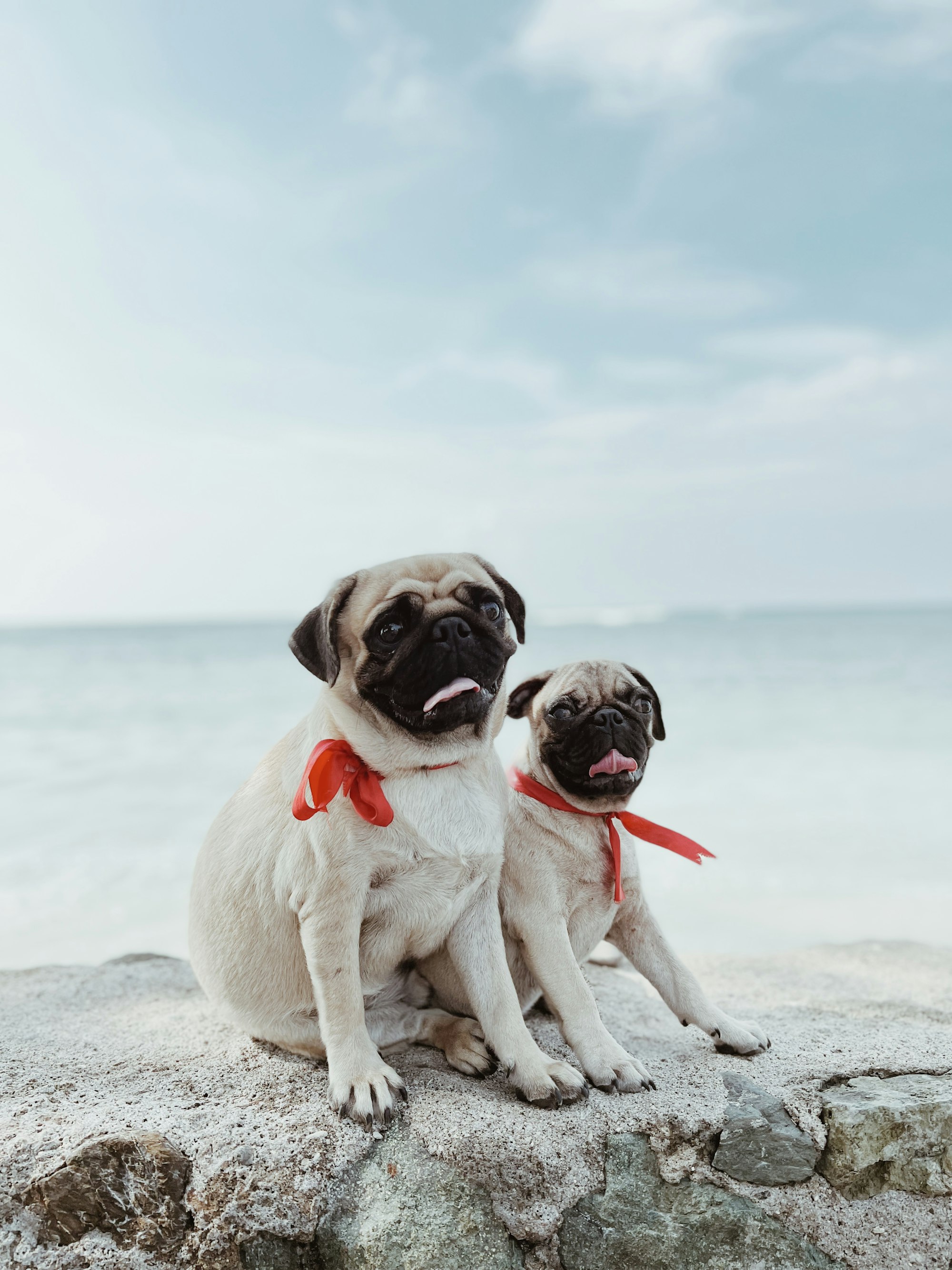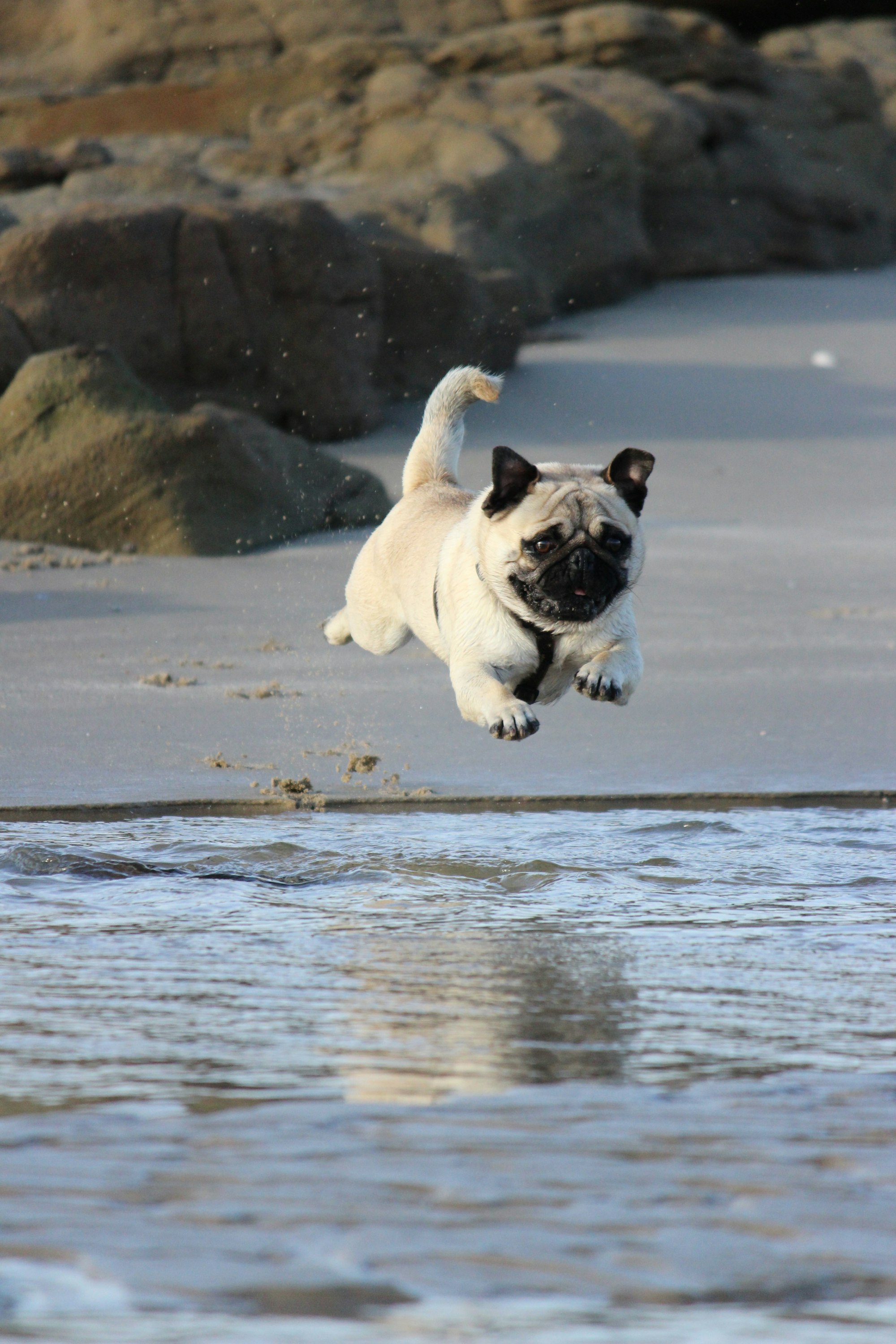When it comes to lovable and adorable dog breeds, pugs often steal the show with their unique appearance and friendly demeanor. While most people are familiar with the standard fawn or black pugs, there is another delightful variant that captures hearts everywhere: the white pug. In this article, we will explore the captivating world of white pugs, shedding light on their origins, characteristics, care requirements, and much more. So, let's dive into the enchanting world of these charming canine companions.

White pugs trace their ancestry back to ancient China, where they were highly regarded as royal companions. Their history can be intertwined with the traditional fawn pugs, as both variations share a common lineage. However, white pugs possess a distinct genetic mutation that results in their unique coat color. Over time, these lovable canines made their way to Europe and eventually gained popularity worldwide.
Appearance and Physical Features
White pugs exhibit the same distinctive facial features as their fawn and black counterparts. They have a wrinkled forehead, large round eyes, and a short, flat muzzle that gives them an endearing and slightly comical expression. In terms of size, white pugs are compact and sturdy, with a height ranging from 10 to 13 inches (25 to 33 cm) and a weight between 14 to 18 pounds (6 to 8 kg).
The coat of a white pug is their most distinguishing feature. It is typically a creamy white or pale silver color, which sets them apart from the more common fawn or black pugs. The coat is short, smooth, and soft to the touch. Unlike some other dog breeds, white pugs do not have an undercoat, making their grooming needs relatively low maintenance.
Their body structure is muscular and well-proportioned, with a broad chest and a slightly arched back. The legs are sturdy and straight, providing them with good balance and agility. White pugs have distinctively curled tail that rests tightly against their body.
One of the most captivating aspects of white pugs is their expressive face. Their large, round eyes are dark and lustrous, exuding a gentle and affectionate gaze. The deep wrinkles on their forehead add character to their appearance, giving them a wise and thoughtful expression.
Overall, white pugs possess a unique and charming aesthetic that captures the hearts of
dog lovers everywhere. Their compact size, distinctive coat color, and adorable facial features make them irresistible companions for those seeking a delightful canine companion.
Temperament and Personality Traits

White pugs are renowned for their friendly and affectionate nature, making them wonderful companions for individuals and families alike. They have a loving and sociable disposition that endears them to everyone they meet. Here are some key temperament and personality traits that make white pugs so special:
1. Playful and Lively: White pugs have a playful spirit that brings joy to their owners' lives. They possess a natural zest for life and enjoy engaging in interactive play sessions. Their exuberance and energy are contagious, making them a source of entertainment and laughter.
2. Affectionate and Loving: White pugs thrive on human companionship and are known for their unwavering loyalty and affection towards their owners. They form strong bonds with their family members and enjoy being by their side, offering endless cuddles and companionship.
3. Sociable and Friendly: White pugs have a natural ability to get along well with people of all ages, including children. They are sociable by nature and enjoy meeting new people and making new friends. Their friendly demeanor makes them excellent family pets and beloved members of the household.
4. Easygoing and Adaptable: White pugs have a laid-back and easygoing nature, which allows them to adapt well to different living situations. Whether you live in a spacious house or a cozy apartment, they can thrive as long as they receive adequate love, care, and attention.
5. Good with Other Pets: White pugs generally get along well with other pets, including dogs and cats, especially if they are properly socialized from an early age. Their friendly nature helps foster positive relationships with furry friends, creating a harmonious household.
6. Alert and Protective: Despite their small size, white pugs have a keen sense of awareness and make excellent watchdogs. They will readily alert their owners to any unusual sounds or activities, making them an effective deterrent against potential intruders.
7. Easy to Train: White pugs are intelligent dogs that respond well to positive reinforcement training methods. They are eager to please their owners, making the training process enjoyable and rewarding. Consistency, patience, and gentle guidance are the keys to successfully training a white pug.

8. Calm and Relaxed: While white pugs have bursts of energy during playtime, they also have a calm and relaxed side. They are content to snuggle up next to their owners and enjoy quiet moments of relaxation. Their calm demeanor makes them suitable companions for individuals or families seeking a laid-back canine companion.
Training and Exercise Needs
White pugs are intelligent and respond well to positive reinforcement training methods. They have a playful nature, which can make training sessions enjoyable for both the dog and the owner. It's important to start training and socializing a white pug from an early age to ensure they grow up to be well-behaved and obedient. Although they are not high-energy dogs, regular exercise is essential to keep them healthy and prevent obesity.
Grooming and Care Tips
Grooming plays an essential role in maintaining the overall health and appearance of white pugs. While their coat is relatively low-maintenance, regular care is still necessary. Here are some grooming and care tips for keeping your white pug looking and feeling their best:
1. Brushing: White pugs have short hair that requires regular brushing to remove loose fur, prevent matting, and distribute natural oils. Brush their coat at least once a week using a soft-bristle brush or a grooming mitt. This not only keeps their coat in good condition but also helps minimize shedding.
2. Bathing: White pugs should be bathed on an as-needed basis, typically every 4 to 6 weeks. Use a mild dog shampoo specifically formulated for sensitive skin. Be sure to rinse thoroughly to remove all traces of shampoo, as any residue left behind can cause skin irritation. After bathing, dry their coat completely to prevent moisture-related skin problems.

3. Ear Cleaning: Regularly check and clean your white pug's ears to prevent wax buildup and infections. Use a veterinarian-recommended ear-cleaning solution and gently wipe the outer part of the ear with a cotton ball or soft cloth. Avoid inserting anything into the ear canal, as this can cause injury.
4. Dental Care: Dental hygiene is crucial for white pugs, as they are prone to dental issues. Establish a regular teeth-brushing routine using dog-friendly toothpaste and toothbrush. Additionally, provide dental chews or toys that help remove plaque and tartar buildup.
5. Nail Trimming: Trim your white pug's nails regularly to maintain their paw health. Overgrown nails can cause discomfort and difficulty in walking. Use a dog nail clipper or grinder, or consult a professional groomer for assistance if you're not familiar with the process.
6. Eye Care: White pugs may be more susceptible to eye-related issues due to their light-colored coat. Keep their eye area clean and free from discharge by gently wiping it with a clean, damp cloth. If you notice excessive tearing, redness, or any signs of eye irritation, consult a veterinarian.
7. Healthy Diet: Proper nutrition is essential for maintaining the overall health of your white pug. Feed them a balanced diet that is appropriate for their age, size, and activity level. Consult with a veterinarian to determine the right type and amount of food to ensure they receive all the necessary nutrients.
Feeding and Nutritional Requirements
Maintaining a healthy diet is crucial for the overall well-being of white pugs. Providing them with high-quality dog food that meets their nutritional needs is essential. It's important to follow the feeding guidelines provided by the manufacturer and adjust portion sizes based on the dog's age, activity level, and weight. Avoid overfeeding to prevent obesity, which can lead to various health problems in obese dogs or pugs.
Health Considerations
While white pugs are generally robust and healthy, they are prone to specific health issues that commonly affect the pug breed. It's necessary to be aware of these conditions and take proactive measures to keep your white pug in good health. Here are some health considerations to keep in mind:
1. Respiratory Problems: Pugs, including white pugs, have a brachycephalic (flat-faced) anatomy, which can lead to respiratory difficulties. They may experience breathing problems, snoring, intolerance to heat, and strenuous exercise. Avoid exposing them to extreme temperatures and ensure they have access to fresh air and water.
2. Eye Conditions: Pugs are prone to various eye conditions, including corneal ulcers, dry eye, and entropion (inward rolling of the eyelids). Regularly inspect your white pug's eyes for any signs of redness, discharge, or excessive tearing. Consult a veterinarian if you notice any abnormalities or concerns.
3. Skin Allergies: Some white pugs may develop skin allergies or sensitivities. Monitor their skin for signs of itching, redness, rashes, or excessive flaking. Allergies can be triggered by certain foods, environmental factors, or allergens. Consult a veterinarian if you suspect your white pug has allergies.
4. Obesity: Pugs have a tendency to gain weight, which can put additional strain on their joints and exacerbate respiratory issues. Maintain a healthy weight for your white pug through a balanced diet and regular exercise. Avoid overfeeding and provide appropriate portion sizes.
5. Regular Veterinary Check-ups: Schedule regular veterinary check-ups for your white pug to monitor their overall health and catch any potential issues early on. Vaccinations, parasite prevention, and routine examinations are essential for their well-being.

White Pug vs. Standard Pug: What's the Difference?
The primary difference between white pugs and standard pugs lies in their coat color. White pugs have a creamy white or pale silver coat, while standard pugs come in fawn or black colors. Aside from their appearance, both variations share similar physical and temperamental traits. It ultimately comes down to personal preference when choosing between the two, as the loving and endearing qualities of pugs are present in both types.
Choosing a White Pug: Adoption or Breeder?
When considering adding a white pug to your family, there are two primary options: adoption or buying from a reputable breeder. Adoption is a wonderful way to provide a loving home for a happy dog in need, and there are breed-specific rescue organizations that may have white pugs available for adoption. Alternatively, reputable breeders can offer healthy white pug puppies with proper documentation and lineage information. Whichever route you choose, remember to do thorough research and ensure the welfare of the dog is a priority.
White Pugs as Family Pets
White pugs make fantastic family pets due to their affectionate and gentle nature. They get along well with children and tend to be patient and tolerant. However, it's critical to teach children how to interact with dogs respectfully and supervise their interactions to avoid any unintentional harm. With proper training, care, and love, white pugs can bring immense joy and happiness to any family.
Final Thoughts
White pugs add a touch of elegance and charm to the already adorable pug breed. Their unique coat color, coupled with their friendly and affectionate nature, makes them irresistible companions for dog lovers. Whether you choose to adopt or purchase a white pug, providing them with love, care, and attention is key to ensuring a happy and fulfilling life for these delightful canines. So, embrace the joy of owning a white pug and experience the unconditional love they have to offer.
Frequently Asked Questions (FAQs)
1. Are white pugs more prone to health issues than standard pugs?
A: White pugs are not inherently more prone to health issues. They share the same health concerns as standard pugs, and proper care and regular veterinary check-ups are essential for their well-being.
2. Do white pugs require more grooming compared to standard pugs?
A: White pugs have a similar grooming requirement as standard pugs. Regular brushing, dental care, and cleaning their eyes and ears are required parts of their grooming routine.
3. Can white pugs live in apartments?
A: Yes, white pugs can adapt well to apartment living. However, they still need regular exercise and mental stimulation, so daily walks and playtime are necessary.
4. Are white pugs good with children?
A: Yes, white pugs are generally good with children. They have a friendly and patient nature, making them suitable companions for families with kids. However, supervision and teaching children how to interact with dogs are essential.
5. Can white pugs participate in dog shows? A: Yes, white pugs can participate in dog shows. However, it's essential to follow the specific breed standards and guidelines set by the kennel clubs organizing the shows.






